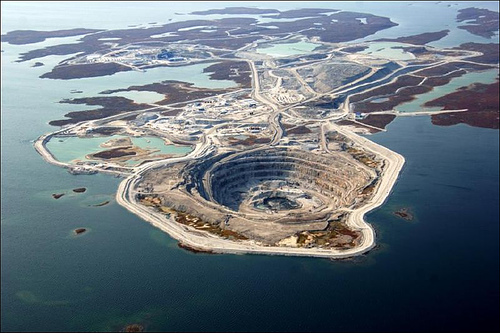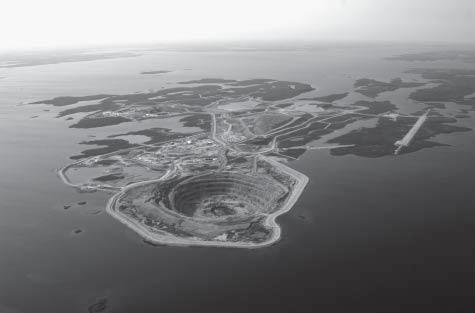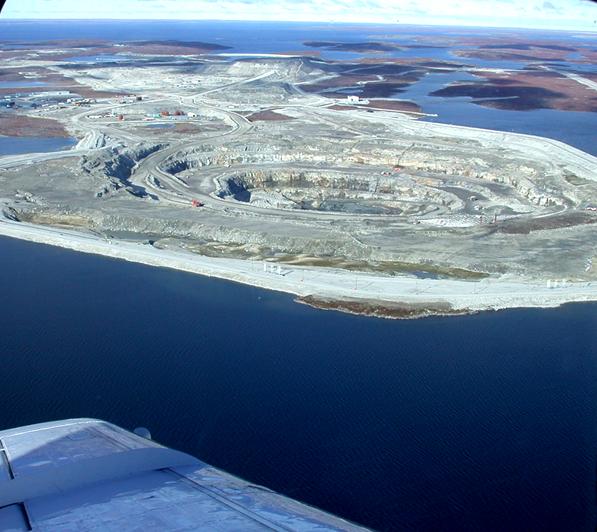Many of the Canadian Diamonds which we offer are manufactured using diamond rough which was sourced from the Diavik Diamond Mine which is located on a 20 kilometer square island, informally called East Island, which is in Lac de Gras located within the Northwest Territory of Canada approximately 300 kilometers as the crow flies Northeast of Yellowknife which is the Capital of Canada's Northwest Territories. The Artic Circle is located about 220 kilometers North of the mine. The key to operating a mine in Canada's remote wilderness is a private ice road which is shared by various mining companies that are operating in the area. The road has been in operation for about twenty years and must be rebuilt annually to maintain service. Approximately 75% of the road is ice and is built over frozen lakes.
Geology: The Diavik Diamond Mine was discovered in Precambrian rocks of the Slave Geological Province. Known to host deposits of gold, copper, zinc, nickel, and now diamonds, this ancient rock is among the world’s oldest and was formed about 2.7 to 2.5 billion years ago. The Slave Geological Province has produced much of the North’s mineral wealth.
Granitic rocks predominantly underlie the area, and have been intruded into slightly older meta-sedimentary rocks, originally deposited as sandstone and shale. The geology of the project area is typical of ancient, 2.5-2.7 billion-year-old Precambrian rocks, with a mixture of metamorphosed sedimentary (metaturbidites) and granitic (e.g. granite, tonalite) rocks. The kimberlite pipes at the Diavik Diamond Mine are volcanic cores injected into the much older, granitic and meta-sedimentary rocks a mere 55 million years ago. Relatively fresh, often charred – but not petrified – wood found only in China today, has been encountered in drill core at depths up to 400 metres. Reflecting a much warmer climate at that time, the coniferous trees were uprooted and incorporated into the pipes.
What are Kimberlite Pipes?
Kimberlite is a rare rock type commonly found in carrot-shaped pipes which represent the roots of ancient, small volcanoes. A drawing of a carrot shaped kimberlite pipe appears above. Originating from over 150 km below the earth’s surface where diamonds are commonly formed, the kimberlite may bring diamonds to surface. Globally, kimberlite pipes average 12 hectares in surface area, and may reach depths of several hundred metres. The kimber pipes used by the Diavik Diamond Mine range in surface area from 0.9 to 1.6 hectares, and extend below 400 metres.
The Exploration for Diamonds
Finding diamond deposits is difficult and costly. Rather than look for the elusive and rare diamonds, geologists seek other clues. Working from tent camps, geologists conduct several types of surveys. Using geochemical surveys, soil samples are taken and panned for indicator minerals like garnets found in more abundance in kimberlite pipes. A trail of indicator minerals can lead to potential pipes. In addition, geophysical surveys are used to differentiate hidden kimberlite pipes from surrounding host rock. Computer-generated geophysical data is mapped as pictured above. If a potential kimberlite target is identified, portable diamond drills are used to remove core samples to determine if the target is in fact kimberlite. Further drilling helps define pipe size and shape, and provides additional rock for diamond testing. Not all kimberlite pipes have diamonds. In fact, of the worlds estimated 5,000 kimberlites only 23 contain enough diamonds to warrant the expense of operating a mining operation. When diamonds are found in sufficient quantities to suggest an ore body, a small mining operation is conducted to remove a larger, several thousand tonne bulk sample. This sample is processed to remove the diamonds, which are then evaluated for quantity, quality, and size.
Lac de Gras
Aboriginal people named the Lake Ekati for quartz veins found in local bedrock outcrops resembling caribou fat. Lac de Gras is 60 kilometers long and averages 16 kilometers wide with a shoreline length of 740 kilometers. The lake averages 12 meters in depth and has a maximum depth of 56 meters. The water temperature ranges from 0°C to 18°C in the summer. Aquatic productivity is low due to low nutrients, low light during the winter, eight months of ice and low water temperatures. The water quality resembles distilled water. The lake is habitated by lake trout, cisco, whitefish, artic grayling, burbot, longnose sucker and slimy sculpin. The lake has a drainage area of about 4,000 square kilometers and together with Lac du Sauvage located to the Northeast form the headwaters of the Coppermine River which flows 520 kilometers from Western Lac de Gras to the Artic Ocean.
The Region
Rolling tundra surrounds the Diavik Diamond Mine. The region was originally named the “Barren Lands” by early explorers due to its lack of trees. The area includes numerous lakes, bedrock outcrops and glacial deposits of boulders, till, and eskers. What little soil is found is of cryosolic order – formed where permafrost occurs within 1-2 metres of the surface – and is characterized by layers that are disrupted, mixed, or broken, by freeze-thaw activity.
Vegetation
Vegetation includes dwarf birch, northern Labrador tea, blueberry, mountain cranberry, and bearberry, with willow, sphagnum moss, and sedge tussocks dominating wet lowlands.
Wildlife
Mammal species that inhabit the region include, grizzly bears, wolves, foxes, arctic hare, ground squirrels, and wolverines. In spring and fall, portions of the Bathurst caribou herd migrate through the region. 84 bird species and 16 mammal species are summer visitors or permanent residents.
Chronological History of the Diavik Mine
*1991- 1992 Aber stakes mineral claims
*March 1992 Exploration begins
*June 1992 Aber Resources, Kennecott Canada Exploration form Diavik joint venture
*1994-1995 Pipes A-21, A154-South, A154-North and A418 discovered
*February 1996 75-person exploration camp erected for underground bulk sampling
*July 1996 5,900 tonne bulk sampling of A418 and A154 South pipes completed
*December 1996 Diavik Diamond Mines Inc. created with head office in Yellowknife
*March 1997 Bulk sample transported over winter road to Yellowknife for processing. Approximately 21,000 carats of diamonds recovered
*June 1997 Environmental baseline studies completed
*September 1997 Pre-feasibility study completed
*March 1998 Project description submitted to Federal Government triggering formal environmental assessment review under the Canadian Environmental Assessment Act
*September 1998 Environmental Assessment Report submitted and Comprehensive Public Involvement Plan initiated
*November 1999 Federal Government approves project for permitting and licensing
*September 2000 Diavik Diamond Mines Inc. receives all necessary permits and licenses to bring mine into production
*December 2000 Investors of Rio Tinto plc and Aber Diamond Corporation approve $1.3 billion expenditure to build mine
*January 2001 Mine construction begins October 2001 A154 dike earthworks completed
*July 2002 A154 dike completed, dewatering commences
*December 2002 Mine virtually complete
*January 2003 Diamond production begins
*May 2003 First million carats
*May 2003 1.9 million accident-free hours
*April 2003 Aber’s first sale of rough diamonds
*July 2003 Rio Tinto Diamonds’ first sale of rough diamonds
Geology: The Diavik Diamond Mine was discovered in Precambrian rocks of the Slave Geological Province. Known to host deposits of gold, copper, zinc, nickel, and now diamonds, this ancient rock is among the world’s oldest and was formed about 2.7 to 2.5 billion years ago. The Slave Geological Province has produced much of the North’s mineral wealth.
Granitic rocks predominantly underlie the area, and have been intruded into slightly older meta-sedimentary rocks, originally deposited as sandstone and shale. The geology of the project area is typical of ancient, 2.5-2.7 billion-year-old Precambrian rocks, with a mixture of metamorphosed sedimentary (metaturbidites) and granitic (e.g. granite, tonalite) rocks. The kimberlite pipes at the Diavik Diamond Mine are volcanic cores injected into the much older, granitic and meta-sedimentary rocks a mere 55 million years ago. Relatively fresh, often charred – but not petrified – wood found only in China today, has been encountered in drill core at depths up to 400 metres. Reflecting a much warmer climate at that time, the coniferous trees were uprooted and incorporated into the pipes.
What are Kimberlite Pipes?
Kimberlite is a rare rock type commonly found in carrot-shaped pipes which represent the roots of ancient, small volcanoes. A drawing of a carrot shaped kimberlite pipe appears above. Originating from over 150 km below the earth’s surface where diamonds are commonly formed, the kimberlite may bring diamonds to surface. Globally, kimberlite pipes average 12 hectares in surface area, and may reach depths of several hundred metres. The kimber pipes used by the Diavik Diamond Mine range in surface area from 0.9 to 1.6 hectares, and extend below 400 metres.
The Exploration for Diamonds
Finding diamond deposits is difficult and costly. Rather than look for the elusive and rare diamonds, geologists seek other clues. Working from tent camps, geologists conduct several types of surveys. Using geochemical surveys, soil samples are taken and panned for indicator minerals like garnets found in more abundance in kimberlite pipes. A trail of indicator minerals can lead to potential pipes. In addition, geophysical surveys are used to differentiate hidden kimberlite pipes from surrounding host rock. Computer-generated geophysical data is mapped as pictured above. If a potential kimberlite target is identified, portable diamond drills are used to remove core samples to determine if the target is in fact kimberlite. Further drilling helps define pipe size and shape, and provides additional rock for diamond testing. Not all kimberlite pipes have diamonds. In fact, of the worlds estimated 5,000 kimberlites only 23 contain enough diamonds to warrant the expense of operating a mining operation. When diamonds are found in sufficient quantities to suggest an ore body, a small mining operation is conducted to remove a larger, several thousand tonne bulk sample. This sample is processed to remove the diamonds, which are then evaluated for quantity, quality, and size.
Lac de Gras
Aboriginal people named the Lake Ekati for quartz veins found in local bedrock outcrops resembling caribou fat. Lac de Gras is 60 kilometers long and averages 16 kilometers wide with a shoreline length of 740 kilometers. The lake averages 12 meters in depth and has a maximum depth of 56 meters. The water temperature ranges from 0°C to 18°C in the summer. Aquatic productivity is low due to low nutrients, low light during the winter, eight months of ice and low water temperatures. The water quality resembles distilled water. The lake is habitated by lake trout, cisco, whitefish, artic grayling, burbot, longnose sucker and slimy sculpin. The lake has a drainage area of about 4,000 square kilometers and together with Lac du Sauvage located to the Northeast form the headwaters of the Coppermine River which flows 520 kilometers from Western Lac de Gras to the Artic Ocean.
The Region
Rolling tundra surrounds the Diavik Diamond Mine. The region was originally named the “Barren Lands” by early explorers due to its lack of trees. The area includes numerous lakes, bedrock outcrops and glacial deposits of boulders, till, and eskers. What little soil is found is of cryosolic order – formed where permafrost occurs within 1-2 metres of the surface – and is characterized by layers that are disrupted, mixed, or broken, by freeze-thaw activity.
Vegetation
Vegetation includes dwarf birch, northern Labrador tea, blueberry, mountain cranberry, and bearberry, with willow, sphagnum moss, and sedge tussocks dominating wet lowlands.
Wildlife
Mammal species that inhabit the region include, grizzly bears, wolves, foxes, arctic hare, ground squirrels, and wolverines. In spring and fall, portions of the Bathurst caribou herd migrate through the region. 84 bird species and 16 mammal species are summer visitors or permanent residents.
Chronological History of the Diavik Mine
*1991- 1992 Aber stakes mineral claims
*March 1992 Exploration begins
*June 1992 Aber Resources, Kennecott Canada Exploration form Diavik joint venture
*1994-1995 Pipes A-21, A154-South, A154-North and A418 discovered
*February 1996 75-person exploration camp erected for underground bulk sampling
*July 1996 5,900 tonne bulk sampling of A418 and A154 South pipes completed
*December 1996 Diavik Diamond Mines Inc. created with head office in Yellowknife
*March 1997 Bulk sample transported over winter road to Yellowknife for processing. Approximately 21,000 carats of diamonds recovered
*June 1997 Environmental baseline studies completed
*September 1997 Pre-feasibility study completed
*March 1998 Project description submitted to Federal Government triggering formal environmental assessment review under the Canadian Environmental Assessment Act
*September 1998 Environmental Assessment Report submitted and Comprehensive Public Involvement Plan initiated
*November 1999 Federal Government approves project for permitting and licensing
*September 2000 Diavik Diamond Mines Inc. receives all necessary permits and licenses to bring mine into production
*December 2000 Investors of Rio Tinto plc and Aber Diamond Corporation approve $1.3 billion expenditure to build mine
*January 2001 Mine construction begins October 2001 A154 dike earthworks completed
*July 2002 A154 dike completed, dewatering commences
*December 2002 Mine virtually complete
*January 2003 Diamond production begins
*May 2003 First million carats
*May 2003 1.9 million accident-free hours
*April 2003 Aber’s first sale of rough diamonds
*July 2003 Rio Tinto Diamonds’ first sale of rough diamonds



 12:44 AM
12:44 AM
 crkota
crkota












 Posted in:
Posted in: 


0 comments:
Post a Comment